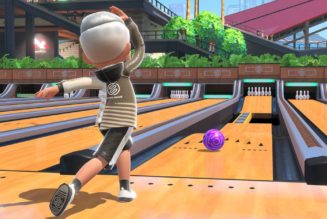Sonic Frontiers broke me. This game frustrated me so thoroughly that when I, at last, put the controller down, I did not feel a sense of accomplishment but one of relief. I wanted to like this game. There were parts I did. But those good moments were overshadowed by an experience that is inconsistent, slow, and riddled with bugs that make you want to hurl your controller through the screen.
Frontiers starts with Sonic, Tails, and Amy crash-landing on an island in search of missing Chaos Emeralds. To free them, Sonic must confront the mysterious program Sage, find the Chaos Emeralds, and combat a slew of monsters that get in his way.
Sonic Frontiers’ greatest sin is that it takes too long to click. I played a demo of the game at Summer Game Fest and was completely on board. That streamlined experience perfectly melded open-world exploration with classic 3D Sonic-level design. When I started the game, none of that original brilliance appeared until the latter quarter of the first area — long after any person with 100 other different things vying for their attention would have rightly put the game down.
To start, you’re dropped, babe-in-the-woods style, into this huge open world and told to just go. You’re given the task of finding Amy, and when you do, you can’t talk to her — you need a certain amount of stuff to speak to her. The game’s entire premise centers on collecting an assortment of tokens. Sonic needs memory tokens to talk to his friends who’ve been sucked into a digital world. He also needs portal gears to unlock spires. Those spires, in turn, open up classic 3D platforming levels — you know, the thing that sells Sonic games. Even then, in these levels, there’s a layer of collecting you must do because completing any number of objectives — finish the stage with a certain number of rings, for example — earns Sonic keys he needs to unlock Chaos Emeralds.
Got all that? Find memory tokens, portal gears, and keys to get the Chaos Emeralds. But wait, there’s more! On top of all that, Sonic’s working with this huge landmass with an utterly blank map. To find the points of interest where he might locate a portal gear or a memory token, he has to uncover that map. Remember in Breath of the Wild how Link would visit a number of shrines and complete, thoughtful challenges using the Sheikah Slate? Imagine that but much, much dumber. The difficulty for the “unlock the map” challenges range from “step on this switch” to “can you draw a circle?”
:no_upscale():format(webp)/cdn.vox-cdn.com/uploads/chorus_asset/file/24216791/ezgif.com_gif_maker__2_.gif)
Since Sonic Frontiers’ map is so large and contains so many map nodes, I’ll grant that the developers can’t make those challenges too complex; otherwise, we’d be dealing with a 324-gigabyte game, and, hey, this ain’t Call of Duty: Modern Warfare II. And some of the challenges were actually really cool. One type requires you to reach a finish line before a timer runs out, making use of the landscape and your platforming skills. Another challenge style has you stepping on lit squares to turn them off without doubling back or jumping. Both styles of challenges were sufficiently complex enough to be enjoyable brain teasers and platforming skill testers, but the lion’s share of them are utterly mindless — you’re given a remarkably easy task with enough time that a timer at all seems superfluous. It seemed like digital busy work, something in there to pad the runtime.
But, somewhat ironically, I didn’t mind the act of collecting the map nodes. I fully, 100 percent completed four of the game’s five islands (one you must complete 100 percent, so it kinda doesn’t count). I thoroughly enjoyed moseying about the world, free-running from one map node to the next, trying to figure out the most creative way to get there. This is where Sonic Frontiers really gets it. The world is littered — and I mean just stuffed — with all kinds of springs and zip lines and balloons and platforms just hanging in the air tempting you and Sonic like “get up here and run on me.” Most of the fun of Frontiers is doing just that. It’s exploration like a Sonic game has never seen before seen, and it’s honestly long overdue for. Bringing that style of 3D platforming in a formless, open world works really friggin’ well, and when I initially started to fall in love with the game, this was why.
:format(webp)/cdn.vox-cdn.com/uploads/chorus_asset/file/24216859/memory.jpeg)
The other reason was the combat. Sonic gets a big-ass level-up in the way he fights. He can kick and punch rather than simply jump on an enemy’s head. (Eat shit, Mario.) And the more you go down his skill tree, the more awesome moves you can pull off. It is very satisfying chaining together the attacks you learn into strings of 100-plus hit combos, and, even better, just about every enemy you face requires a unique strategy. Some will force you to weaken their defenses with a cyloop attack (the aforementioned “draw a circle”). Others will surround and sneak attack you, necessitating parrying all incoming attacks before beating on the downed enemies. Enemy and encounter design is one of the best things in Frontiers and one of its more enjoyable qualities.
The boss fights, too, are really creative. Sonic engages in these knock-down drag-out fights with colossal creatures that have multiple forms and mechanics that bring all your knowledge of Sonic’s skills to bear. The boss fights make you feel like you’re Goku or Superman up against a creature of unfathomable power, and you’re wailing on it while getting wailed on, all while some kick-ass tunes play in the background. Sonic Frontiers’ boss fights are rare moments that a game made me feel like I’m the protagonist in the final fight of a shonen anime — they’re almost, almost worth the price of everything else the game put me through.
And now it’s time to talk about that bullshit.
Once you defeat the first island’s boss, you’re jettisoned to a new location and forced to start all over again, collecting portal gears, keys, and Chaos Emeralds, this time with another one of Sonic’s companions. Unfortunately, any collected memory tokens or keys do not carry over, so I had to start from zero. This was fine initially, as I enjoyed ripping and running throughout the land. But once I got to Tail’s island, the game stopped being fun and started getting painful.
On the islands before Tails’, it’s pretty much over-the-shoulder, 3D open-world platforming. Occasionally, there will be sections in the world where the game removes camera control and hard pivots into 2D side-scrolling. That transition was never quite seamless. Sometimes I’d be running, minding my business when suddenly I couldn’t control my camera anymore, even though I’m not yet fully within the 2D section. That made platforming really difficult, but it was few and far enough between that I didn’t mind. On Tails’ island, that was the majority of the island’s platforming, and it ground what was once fun and fancy-free running into a slog through quicksand with 300lb weights on my feet.
In 2D platforming sections, whether in the open world or one of the portal stages, Sonic doesn’t move very well. Sometimes, even after running on an accelerator, he’ll just stop even if you’re still pushing the analog stick. All his momentum and speed will just disappear. Sonic does have a boost ability that works like a spin dash, but if you’re coming up on a curved loop, boosting, more often than not, will just run you into the wall instead of carrying you through the loop. It’s like the boost only has the ability to make you go fast in a straight line, and curves utterly confound it. Those kinds of momentum problems are multiplied infinitely on an island where the majority of the open world is in these forced-perspective 2D platforming areas.
:format(webp)/cdn.vox-cdn.com/uploads/chorus_asset/file/24216847/koco.jpeg)
If that were the only problem, I could forgive the game. But it wasn’t — by a long shot. Occasionally, as I worked my way through the story, I’d have to participate in one-off mini-games to advance to the next section. Some of them were interesting, like a hacking mini-game reminiscent of the one in Nier: Automata. Other times, you’d have to do nonsensical tasks like pull weeds or herd Chao-like creatures called Koco into a stable.
The Koco are at the heart of Sonic Frontiers’ story, but they don’t really add much, and at times, their story gets in the way of the action, slowing it down with egregiously silly side-quests that don’t really fit into the main flow of the game. The story hand waves an explanation for the Koco’s presence and tries to generate pathos by killing the childlike stone creatures every time you fulfill their quests, but it’s never enough to make me care. It’s just in the way.
There’s a mini-game that makes Sonic play a pinball game in an ancient ruin. (Don’t ask why; it’s Plot — roll with it.) Initially, I was amused by the reference to Sonic Spinball in the way that I was amused with Sonic Mania’s nod to Dr. Robotnik’s Mean Bean Machine. But unlike that moment in Mania, the pinball game dragged on too long. I had to accumulate 5 million points to progress with only three lives to do it. I’m not a pinball wizard; I shouldn’t have to be in a Sonic game. Five million points in three lives is an onerous task, especially when you accumulate multipliers at a snail’s pace. By the time you’ve accumulated a multiplier big enough to put a dent in your point total, you’re on your last life. And once you lose that final life, all the multipliers you’ve earned melt away, and you start over.
:format(webp)/cdn.vox-cdn.com/uploads/chorus_asset/file/24216854/pinball.jpeg)
That’s one of the more upsetting things about Frontiers. The things it asks you to do are either so mindless that they can be done in one’s sleep or so arbitrarily difficult that it makes you wanna ding up your drywall. There is no balance.
I struggled with that pinball game for more than an hour, cursing the game for locking critical progression behind what should have been an optional side-quest and swearing that if I don’t get it in the next try, I’ll simply quit. My husband stepped in and actually got the 5 million points needed on the first try, only to die before hitting the special button to finally end the game. We eventually got it, but my patience with Frontiers had already been zapped to nothing.
After that, the game kept throwing these unfun sections at me, whittling me down to a nub of bitchy frustration. Once Tails’ island was complete, there’s an island where your only goal is to platform your way to the top of these super-tall spires. I fell a lot, so much so that I felt like a Sonic-flavored Sisyphus. All my joy and optimism were gone, and I had transitioned from playing this game for fun to playing this game out of spite. I would not let it defeat me. This was Sonic, for Mobius’ sake. I love Sonic. How could I call myself a fan if I give up?
When I made it to the final island, I ran into an interesting but difficult new monster. After a few rounds of trial and error, I finally had the strategy down cold. I was kicking its ass without a single ring lost. Then I, somehow, fell through the world.
By this point, I’m already dispirited from my experience with this game, and this moment, when I hit pause, that was when my spirit shattered. My experience with Sonic Frontiers can be easily summed up by this clip. Right when I finally started to feel something resembling joy, the game, whether through an unlucky glitch or design flaw, snatched it all away. I almost cried because I was so close to winning before something beyond my control made that impossible. The rest of the game was blessedly uneventful, and I was happy when the credits rolled because it meant I’d never have to look at this game again.
When I first started writing this, looking at the climate of reviews for the game that were either uncritical fawning or downright slander, I thought I’d be able to deliver level-headed, even-keeled criticism. When Sonic Frontiers works, it goes. The things that it does right — the combat, the exploration, the music — breathe life into a franchise that’s somewhat lagged behind its contemporaries in innovation. But when it goes wrong, it’s so painful it very often brought me near to tears of frustration and rage.
I love Sonic. I can’t overstate this enough. And when you love something the way I love Sonic, you want to see them be the best they can be. Sonic Frontiers is nowhere close to being the best. There is a lot of a really good game, but it’s buried and obscured by frustrating mechanics and baffling design decisions.
Sonic Frontiers is out now on Nintendo Switch, PC, Xbox, and PlayStation.









